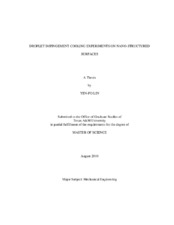| dc.description.abstract | Spray cooling has proven to be efficient in managing thermal load in high power applications. Reliability of electronic products relies on the thermal management and understanding of heat transfer mechanisms including those related to spray cooling. However, to date, several of the key heat transfer mechanisms are still not well understood. An alternative approach for improving the heat transfer performance is to change the film dynamics through surface modification. The main goal of this study is to understand the effects of nano-scale features on flat heater surfaces subjected to spray cooling and to determine the major factors in droplet impingement cooling to estimate their effects in the spray cooling system. Single droplet stream and simultaneous triple droplet stream with two different stream spacings (500 μm and 2000 μm), experiments have been performed to understand the droplet-surface interactions relevant to spray cooling systems.
Experiments have been conducted on nano-structured surfaces as well as on flat (smooth) surfaces. It is observed that nano-structured surfaces result in lower minimum wall temperatures, better heat transfer performance, and more uniform temperature distribution. A new variable, effective thermal diameter (de), was defined based on the radial temperature profiles inside the impact zone to quantify the effects of the nano-structured surface in droplet cooling. Results indicate that larger effective cooling area can be achieved using nano-structured surface in the single droplet stream experiments. In triple stream experiments, nano-structured surface also showed an enhanced heat transfer. In single stream experiments, larger outer ring structures (i.e. larger outer diameters) in the impact crater were observed on the nano-structured surfaces which can be used to explain enhanced heat transfer performance. Smaller stream spacing in triple stream experiments reveal that the outer ring structure is disrupted resulting in lower heat transfer. Lower static contact angle on the nano-structured surface has been observed, which implies that changes in surface properties result in enhanced film dynamics and better heat transfer behavior. The results and conclusions of this study should be useful for understanding the physics of spray cooling and in the design of better spray cooling systems. | en |


